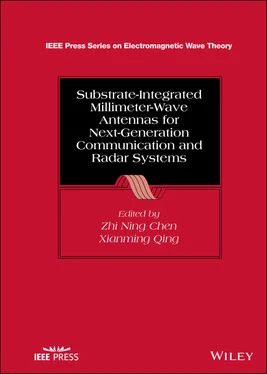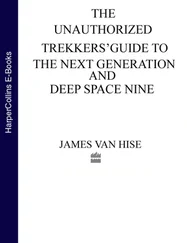In Chapter 9, “Substrate Integrated Antennas for Millimeter Wave Automotive Radars,” Xianming Qing and Zhi Ning Chen introduce the PCB‐based high‐gain substrate integrated mmW antennas for car radar sensors. First, the general aspects of automotive radar are addressed including the classification, the frequency band regulation, system requirements, and antenna design considerations. Second, the selected state‐of‐the‐art antenna designs for 24‐GHz and 77‐GHz automotive radars are reviewed. After that, two types of antenna arrays are introduced. A compact co‐planar waveguide (CPW) center‐fed SIW slot antenna array is elaborated to achieve narrow H ‐plane beamwidth and low sidelobe levels for 24‐GHz automotive radars. A transmit‐array on dual‐layer PCB is introduced for automotive 77‐GHz radar applications. With four SIW slot antennas as the primary feeds, the transmit‐array is able to generate four switched beams. The coplanar structure significantly simplifies the transmit‐array design and eases the fabrication, in particular, at mmW frequencies.
Chapter 10is entitled “Sidelobe Reduction of Substrate Integrated Antenna Arrays at Ka‐Band.” Teng Li first introduces the synthesis technologies of low sidelobe array factors and the optimization methods. To accurately get the desired pattern, a brief analysis of mutual coupling is presented. Then, the selected state‐of‐the‐art feeding technology for SIW array antenna are reviewed. After that, the examples of the small array, monopulse array, and shaped beam array with sidelobe reduction and different feeding technologies are introduced for SIW array antenna at Ka‐band.
In Chapter 11, “Substrate Edge Antennas,” Lei Wang and Xiaoxing Yin introduce substrate edge antennas (SEAs), which radiate from the edges of the PCBs. To diminish the mismatch between the PCB edge and the free space, two types of planar strips are printed in front of the SEA aperture. With the printed strips, both the impedance bandwidth and the front‐to‐back ratio are improved. Aiming at increasing the aperture efficiency, two kinds of substrate‐integrated lenses are embedded in the SEAs. The phase‐correcting lenses are integrated into the SEAs, maintaining the compact profiles of SEAs. Moreover, a leaky‐wave SEA loaded with a prism lens is presented with a fixed‐beam over a wide frequency band. The prism lens is implemented by utilizing a dispersive metasurface. By compensating for the dispersion of the leaky‐wave SEA and the prism lens, fixed radiation beams are achieved over a 20% fraction bandwidth at Ka‐band.
The research, development, and applications of mmW antennas have a long history. With the fast progress in device technologies and rapid deployment of system for a variety of commercial applications, theory, and technologies related to mmW antennas have been extensively investigated and developed [54–64]. This book will address the critical design challenges of mmW antennas for wireless communications and radar systems.
1 1 ITU‐R Recommendation (2015). V.431: “Nomenclature of the frequency and wavelength bands used in telecommunications (Table I).” Geneva: International Telecommunication Union. https://www.itu.int/dms_pubrec/itu-r/rec/v/R-REC-V.431-8-201508-I!!PDF-E.pdf(accessed 19 December 2020).
2 2 Seybold, J.S. (2005). Introduction to RF Propagation, 3–10. Wiley.
3 3 Petty, K.R. and Mahoney, W.P. III (2007). Weather applications and products enabled through vehicle infrastructure integration (VII). (Section 5) United States Department of Transportation – Federal Highway Administration Report No. FHWA‐HOP‐07‐084. https://ops.fhwa.dot.gov/publications/viirpt/viirpt.pdf(accessed 19 December 2020).
4 4 Shannon, C.E. (1949). Communication in the presence of noise. Proc. Inst. Rad. Eng. 37 (1): 10–21.
5 5 Wiltse, J.C. (1984). History of millimeter and submillimeter waves. IEEE Trans. Microwave Theory Tech. 32 (9): 1118–1127.
6 6 Nichols, E.F. and Tear, J.D. (1923). Short electric waves. Phys. Rev. 21: 587–610.
7 7 Nichols, E.F. and Tear, J.D. (1923). Joining the infra‐red and electric wave spectra. Proc. Nat. Acad. Sci. 9: 211–214.
8 8 Tear, J.D. (1923). The optical constants of certain liquids for short electric waves. Phys. Rev. 21: 611–622.
9 9 Cleeton, C.E. and Williams, N.H. (1934). Electromagnetic waves of 1.1cm wave‐length and the absorption spectrum of ammonia. Phys. Rev. 45: 234–237.
10 10 Boot, H.A.H. and Randall, J.T. (1976). Historical notes on the cavity magnetron. IEEE Trans. Electron Dev. 23: 724–729.
11 11 Bennger, R. (1946). The absorption of one‐half centimeter electromagnetic waves in oxygen. Phys. Rev. 70: 53–57.
12 12 Warters, W.D. (1977). WT4 millimeter waveguide system: introduction. Bell Syst. Tech. J. 56: 1925–1928.
13 13 Button, K.J. and Wiltse, J.C. (eds.) (1981). Millimeter Systems, vol. 4, (series on Infrared and Millimeter Waves). NY: Academic.
14 14 Schwartz, R.F. (1954). Bibliography on directional couplers. IRE Trans. Microwave Theory Tech. 2: 58–63.
15 15 Convert, G., Yeou, T., and Pasty, B. (1959). Millimeter‐wave O‐carcinotron. In: Proceedings of Symposium on Millimeter Waves, vol. IX, 313–339.
16 16 Wiltse, J.C. (1959). Some characteristics of dielectric image lines at millimeter wavelengths. IRE Trans. 7: 63–69.
17 17 Taub, J.J., Hindin, H.J., Hinckelmann, O.F., and Wright, M.L. (1963). Submillimeter components using oversize quasi‐optical waveguide. IEEE Trans. Microwave Theory Tech. 11 (9): 338–345.
18 18 Richer, K.A. (1974). Near earth millimeter‐wave radar and radiometry. Proc. IEEE Int. Symp. Microw. Theorv Tech.: 470–474.
19 19 Wiltse, J.C. (1979). Millimeter wave technology and applications. Microw. J. 22: 39–42.
20 20 Chang, K. and Sun, C. (1983). Millimeter‐wave power‐combining techniques. IEEE Trans. Microwave Theory Tech. 31 (2): 91–107.
21 21 Chen, Z.N. (ed.) (2016). Handbook of Antenna Technologies. Springer.
22 22 Balanis, C.A. (2016). Antenna Theory: Analysis and Design, 4e. Wiley.
23 23 Uchimura, H., Takenoshita, T., and Fujii, M. (1998). Development of a “laminated waveguide”. IEEE Trans. Microwave Theory Tech. 46 (12): 2438–2443.
24 24 Takenoshita, T. and Uchimura, H. (1999). Laminated aperture antenna and multilayered wiring board comprising the same. EP20030026894 (Application number in 1998) and EP0893842B1(Grant number in 2004). https://patentimages.storage.googleapis.com/74/5e/eb/c2c2e031af31c7/EP0893842A2.pdf(accessed 19 December 2020).
25 25 Hirokawa, J. and Ando, M. (1998). Single‐layer feed waveguide consisting of posts for plane TEM wave excitation in parallel plates. IEEE Trans. Antennas Propag. 46 (5): 625–630.
26 26 Deslandes, D. and Wu, K. (2001). Integrated microstrip and rectangular waveguide in planar form. IEEE Microwave Wirel. Compon. Lett. 11 (2): 68–70.
27 27 Yan, L., Hong, W., Hua, G. et al. (2004). Simulation and experiment on SIW slot array antennas. IEEE Microwave Wirel. Compon. Lett. 14 (9): 446–448.
28 28 Sebastian, M.T., Ubic, R., and Jantunen, H. (eds.) (2017). Microwave Materials and Applications. Wiley.
29 29 Sebastian, M. and Jantunen, H. (2008). Low loss dielectric materials for LTCC applications. Int. Mat. Rev. 53 (2): 57–90.
30 30 Ullah, U., Ain, M.F., Mahyuddin, N.M. et al. (2015). Antenna in LTCC technologies: a review and the current state of the art. IEEE Antennas Propag. Mag. 57 (2): 241–260.
31 31 Deslandes, D. and Wu, K. (2006). Accurate modeling, wave mechanisms, and design considerations of a substrate integrated waveguide. IEEE Trans. Microwave Theory Tech. 54 (6): 2516–2526.
32 32 She, Y., Tran, T.H., Hashimoto, K. et al. (2011). Loss of post‐wall waveguides and efficiency estimation of parallel‐plate slot arrays fed by the post‐wall waveguide in the millimeter‐wave band. IEICE Trans. Electron. E94‐C (3): 312–320.
Читать дальше












